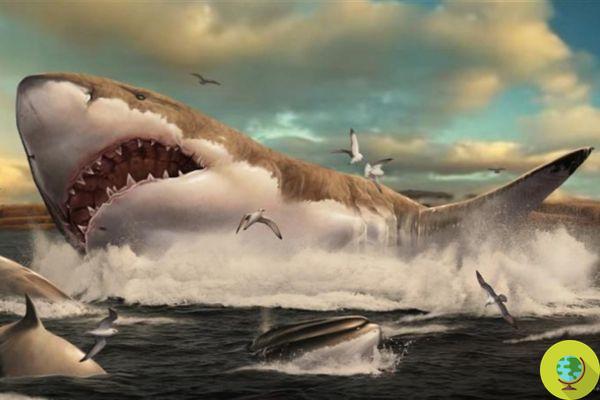
How did the megalodon become extinct? It was probably due to the drop in sea level due to the lowering of global temperatures
He is about to end up run over, his mother saves himThey are fully considered to be the largest sharks that have ever roamed the world's oceans. They raised their young in warm, shallow water nurseries where food was plentiful and predators were in short supply until they were able to make it on their own. But at some point they died out. Now, a new study of ancient fossil teeth could reveal the answer to the megalodon's disappearance.
The cause may have been the drop in temperatures and the consequent lowering of the sea level. Thus the megalodon (Otodus megalodons) may have found fewer and fewer safe coastal areas where its young could safely reach adulthood. Researchers from the University of Valencia speculated this in a study published in the journal Biology Letters of the Royal Society.
Indeed, the megalodon's dependence on nurseries may have contributed to the end of its 20 million-year reign. Sometimes classified as a Carcharocles megalodon, it took 25 years to grow into an adult, "extremely retarded sexual maturity," the authors said in the research paper.
But when fully grown, the shark could reach 18 feet, three times the size of the largest in the world, the white shark. As an apex predator, and until its extinction about three million years ago, the adult megalodon was unrivaled among other ocean hunters and fed on smaller sharks and even whales.
But her young were vulnerable to attacks from other predators, often other sharks. Nurseries on shallow continental shelves with lots of smaller fish for food and few competing predators gave them the perfect space to reach their impressive size.
"Our results reveal, for the first time, that nursery areas were commonly used by the Megalodon on large time and space scales," the authors said.
The research team discovered a nursery area off the east coast of Spain in the province of Tarragona after visiting a museum and observing a collection of megalodon teeth.
"Many of them were quite small for such a large animal," British University of Bristol authors Carlos Martinez-Perez and Humberto Ferron told AFP.
Judging by the size of the teeth, they speculated that the area was once home to young megalodons.
“The Spanish nursery could be described as 'a perfect place to grow up,' the authors said. It would have been a "shallow bay of warm waters, connected to the sea and with extensive coral reefs and an abundance of invertebrates, fish species, marine mammals and other sharks and rays."
The researchers analyzed eight other sets of shark teeth that had previously been collected, scattered throughout the United States, Peru, Panama and Chile. Looking at them, they concluded that four - two in the United States and two in Panama - belonged to sharks more young. Consequently, the authors suggest that the four areas where the teeth were found may also have been nurseries.
Sharks continuously lose their teeth throughout their lives and nurseries are areas with a high abundance of sharks.
"As a result, huge numbers of teeth can be lost, increasing the chances of later fossil discoveries," the authors said.
Megalodons thrived in the warm, temperate waters of the Miocene that stretched from about 5 to 23 million years ago.
But the colder period of the Pliocene was probably much less suitable for them. As their prey adapted and headed for colder waters, the megalodon stayed where the oceans were still warm. Thus, there was a large reduction in shallow water nurseries due to the drop in sea level, caused by a cooler climate. This may also have contributed to the extinction of the megalodon.
Sources of reference: ScienceAlert, Biology Letters
READ also:
- The largest fish in the sea is officially female!


























